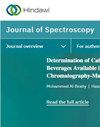线性加性条件在近红外漫反射吸收光谱中的应用
IF 2.1
4区 化学
Q4 BIOCHEMICAL RESEARCH METHODS
引用次数: 0
摘要
在产品加工过程中实时确定物料混合的均匀性对质量控制至关重要。根据漫反射吸收光谱的Kubelka-Munk (K-M)函数,当样品散射系数S在一定范围内时,吸光度A与组分含量近似成线性关系。S由粉末样品的粒度决定。因此,本研究确定了近红外漫反射光谱(NIRDRS)中满足线性可加性的粒径范围。因此,提出的NIRDRS分析技术可用于确定材料混合物的均匀性或分析混合物中组分的百分比。在本研究中,使用维生素B3和维生素C制备不同百分比的混合样品。实验结果表明,粉末粒度在280 μm、280 ~ 450 μm和450 ~ 900 μm范围内均满足线性可加性。当置信水平为0.01时,实际混合光谱与线性加法构建的“模拟混合光谱”差异不显著,相对偏差小于1.08%。混合物中各组分的实际百分比和分析百分比的绝对误差在2.98%以内。上述结论同样适用于物质组成复杂的高粱。统计模型不能分析混合物中各成分的百分比。相比之下,线性添加和直接校准方法避免了使用大量样本进行统计建模和分析混合样本的百分比。同时,通过建立力学模型,对物料混合均匀性进行判别和分析。本文章由计算机程序翻译,如有差异,请以英文原文为准。
Application of Linear Additive Conditions for Near-Infrared Diffuse Reflectance Absorption Spectroscopy
Determining the homogeneity of material mixing in real time during product processing is critical for quality control. According to the Kubelka–Munk (K-M) function of diffuse reflectance absorption spectrum, absorbance (A) is approximately linear with the content of the components when the sample scattering coefficient (S) is in a certain range. The S is determined by the particle size of powder samples. Therefore, this study determined particle size ranges that satisfy linear additivity in near-infrared diffuse reflectance spectroscopy (NIRDRS). Thus, the proposed NIRDRS analysis technique can be used to determine the homogeneity of material mixes or analyze the percentages of the components in the mixture. In this study, vitamin B3 and vitamin C were used for preparing mixed samples with varying percentages. The experimental results revealed that linear additivity is satisfied when the powder particle size is in the range of less than 280, 280–450, and 450–900 μm. When the confidence level is 0.01, the actual mixed spectra are not significantly different from the “simulated mixed spectra” constructed by linear addition, with their relative deviations less than 1.08%. The absolute errors of the actual and analytic percentages were within 2.98% for each component in the mixtures. The above conclusions also hold for sorghum, which has a complex material composition. Statistical models cannot analyze the percentages of components in the mixture. In contrast, linear addition and direct calibration approach avoids the use of a large number of samples for statistical modeling and analyze the percentages of mixed samples. Meanwhile, it can be used to discriminate and analyze the material mixing uniformity by building a mechanistic model.
求助全文
通过发布文献求助,成功后即可免费获取论文全文。
去求助
来源期刊

Journal of Spectroscopy
BIOCHEMICAL RESEARCH METHODS-SPECTROSCOPY
CiteScore
3.00
自引率
0.00%
发文量
37
审稿时长
15 weeks
期刊介绍:
Journal of Spectroscopy (formerly titled Spectroscopy: An International Journal) is a peer-reviewed, open access journal that publishes original research articles as well as review articles in all areas of spectroscopy.
 求助内容:
求助内容: 应助结果提醒方式:
应助结果提醒方式:


